Thinking about iPhone Pricing
Thinking about iPhone Pricing
Before the 5C was well-known, I argued that sticking with just one new iPhone model a year had a dangerous precedent: Ford, and the Model-T :
Still, the idea that Ford became overly focused on production as opposed to customer needs is a worrying one; if this fall brings nothing more than a 5S, with the same form factor as the 5, well, that will be great for production costs, but not so great for customers who prefer a larger phone, or a cheaper one (and remember, Cook is a production guy, not a product one).
It was controversial to suggest Apple might add SKUs – heck, it’s still controversial today – even though the logic is inexorable.
A quick aside about pricing and segmentation
The most elementary thing to understand about pricing is the demand curve. In general, and as one might expect, the quantity sold has an inverse correlation to price.
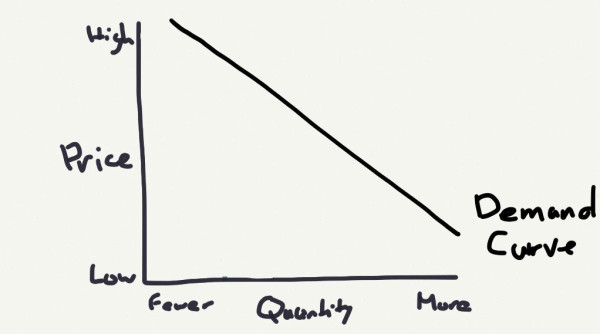
The trouble with only selling one product is that you can only hit one spot on the demand curve; you don’t have a product for customers who fall lower on the demand curve (red in the illustration), and you are charging less than you could to those higher on the demand curve (yellow).
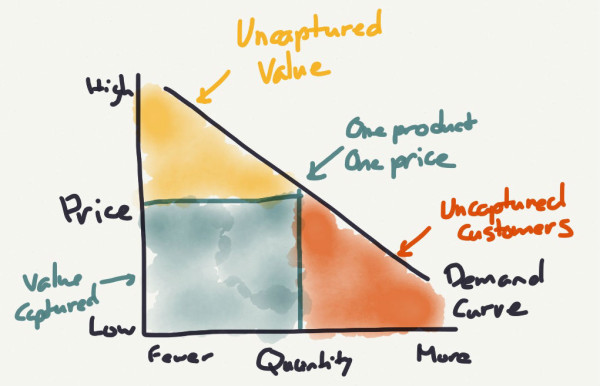
This is why companies typically sell multiple variations of a product; the idea is to also sell a higher-priced product that appeals to those willing to spend more, and a lower-priced product that attracts those lower down the demand curve. Ideally, the lower-priced product doesn’t cannibalize the higher-priced ones.

In this case, a company can capture much more of the value in the market.
Apple’s iPhone Strategy Until Now
Famously, Apple has eschewed segmenting the iPhone’s market. There are lots of reasons this could be the case, but I think the simplest explanation is also the correct one: the iPhone 5 is the first iPhone that Apple believes is “good enough”.
When a product category is brand new, the first few offerings are always deficient. They’re too slow, too big, missing features, compromised, etc. But, this being technology, the improvement is remarkably rapid. Most of this improvement is at the high-end, but soon it is possible to make a mid-range offering, and then a low-end. However, as long as the market is still immature, the leaps in quality year-over-year are significant and, more importantly, perceptible to average customers.
In the case of the iPhone, the 3G was clearly better than the 1st iPhone (enclosure notwithstanding), as was the 3GS relative to the 3G, and the 4 to the 3GS. Ultimately, Apple feels it was the iPhone 5 that is “good enough,” as seen by their willingness to finally make a mid-range version.
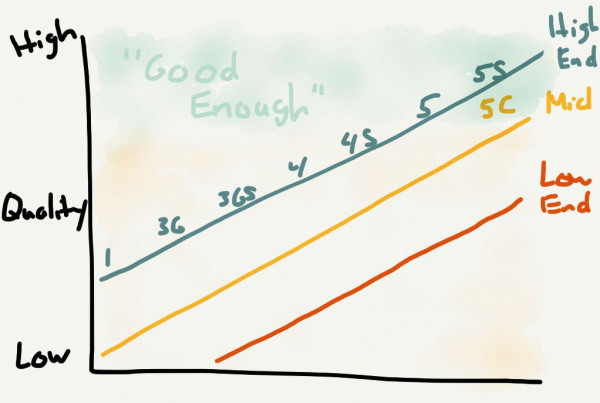
The “good enough” threshold is a dangerous one for the integrated innovator, as that is when modular substitutes start to catch up in the overall experience. While the iPhone retains lots of advantages and strong lock-in, to not offer a second, lower (not low) priced iPhone would be a mistake.
In fact, the primary mistake Apple has made, if they made one, was in determining exactly where the “good enough” line is at. The iPhone 4S is arguably “good enough” and could have been the basis for a mid-range model last year. Apple thought otherwise though; I would imagine a not insignificant factor is that the iPhone 5 is the first iPhone with a fully Apple-designed SoC , the A6.
Regardless, the line has been set; clearly we won’t see a truly low-priced iPhone until Apple can include iPhone 5-level technology at a price they are comfortable with.
So What is the Price?
Given the high bar Apple has set (iPhone 5 technology), I (now 1 ) expect the iPhone 5C’s price to be on the high end of estimates, and possibly higher.
The fact the 5C needs to be sold in both subsidized and unsubsidized markets makes the pricing tricky; in subsidized markets, Apple is currently receiving a subsidy of around $450 on the iPhone 5. It wouldn’t make sense to unilaterally lower that – after all, it’s not like the carriers are going to lower iPhone service bills. This sets a floor of $450 for the unsubsidized 5C ($0 with contract). This also lets Apple dump the 4S, with its 3.5″ screen, 30-pin connector, and lack of LTE.
$0, though, is problematic from a branding perspective. While a new phone, heavily advertised (unlike the old iPhone 4) and sold for $0 would move an incredible number of units, it would also create consumer expectations around $0 and associate Apple with “cheap.” I would imagine Apple is very hesitant to go there. $99 makes more sense. (This point on branding applies to the unsubsidized cost as well; in Asia, in particular, the iPhone’s biggest selling point is brand prestige, not apps or user experience. Apple will be happy to err on the side of more expensive.)
$99, however, implies an unsubsidized cost of $550. While certainly cheaper than the 5S, it’s not clear that $100 delta is worth the additional complexity of an entirely new phone.
In other words, to answer this section’s heading, I’m still not sure. Something has to give, whether it be the subsidy amount, avoiding the brand association with $0, or a too-high price. I’m leaning towards a lower subsidy, meaning a price of $450/$99; 2 that may also be why NTT DoCoMo and China Mobile will finally sell the iPhone. Still, I wouldn’t be surprised at $450/$0. ( Update: I’m hearing $550/$99 has a good chance, but totally unconfirmed ).
How is This Strategy Different?
It is true that Apple has been selling multiple iPhones for a few years now; right now they sell the iPhone 5 for $650/$199, the iPhone 4S for $550/$99, and the iPhone 4 for $450/$0. However, while this does capture some customers further down the demand curve, I think that the overall demand for “old” iPhones is much lower than demand for “new” iPhones.
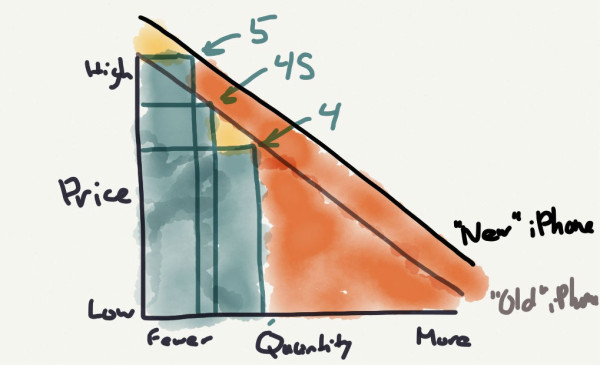
The 5C, on the other hand, will be about as “new” as an iPhone can get, particularly with it’s colorful enclosures. Even if it’s priced the same as an iPhone 4S or 4, it will sell many, many more units because of stronger demand.
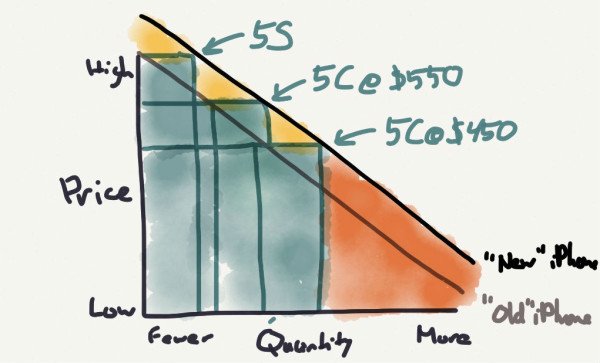
I expect the 5C to be a massive hit, not just internationally, but also in the US and other subsidized markets. This suggests a significant drop is the iPhone average selling price, but a big bump in top line revenue. The margin impact isn’t clear; iPhone 5 internals sold at $450 will likely cause a decent, but not huge, dip.
What about the iPhone 5S?
The 5C clearly targets two iPhone growth opportunities: unsubsidized markets, and price-sensitive customers in subsidized markets. However, there is one other huge opportunity that Apple has always been reticent to target: enterprise.
The implosion of RIM and fragmentation of Android are increasingly leaving the iPhone as the default choice of more and more enterprises, and it’s in this light that the rumored fingerprint sensing technology is particularly interesting.
Most corporate laptops require two-factor identification. Previously, this meant a key card, although most now use the TPM chip with a separate password. Phones have been managed; IT departments can require a strong password, and remotely wipe a device, but there is no way to do 2-factor authorization, even though smartphones are just as much a computer as the laptops used 5 or 10 years ago.
In this light the fingerprint scanner is very useful: a fingerprint + password = 2-factor authentication. I could absolutely see the 5S being the first Apple product to not just infiltrate the enterprise from the ground up, but to be actively encouraged and even required by IT departments.
For this reason, I don’t think the 5C will have the scanner; even Apple will do something to protect their high end.
- I previously argued rather stridently that the iPhone 5C ought to be very aggressivly priced, although even then I was struggling with the subsidized versus unsubsidized pricing problem, and quickly changed my mind . I do think that Apple has been slow in moving the iPhone to lower price points, and are suffering for it particularly in Asia. Perhaps I’ve been influenced too much by what I see, but there’s no question there are fewer iPhones relative to Android here in Taiwan than there were two years ago. Still, it really would have been out of character for Apple to be that aggressive; it increasingly seems the iPod, which was always price-competitive, was more of an aberration [ ↩ ]
- In this case, the 4S stays at $0 subsidized. Regardless, in all cases I think the 5 will be discontinued [ ↩ ]
文章版权归原作者所有。
